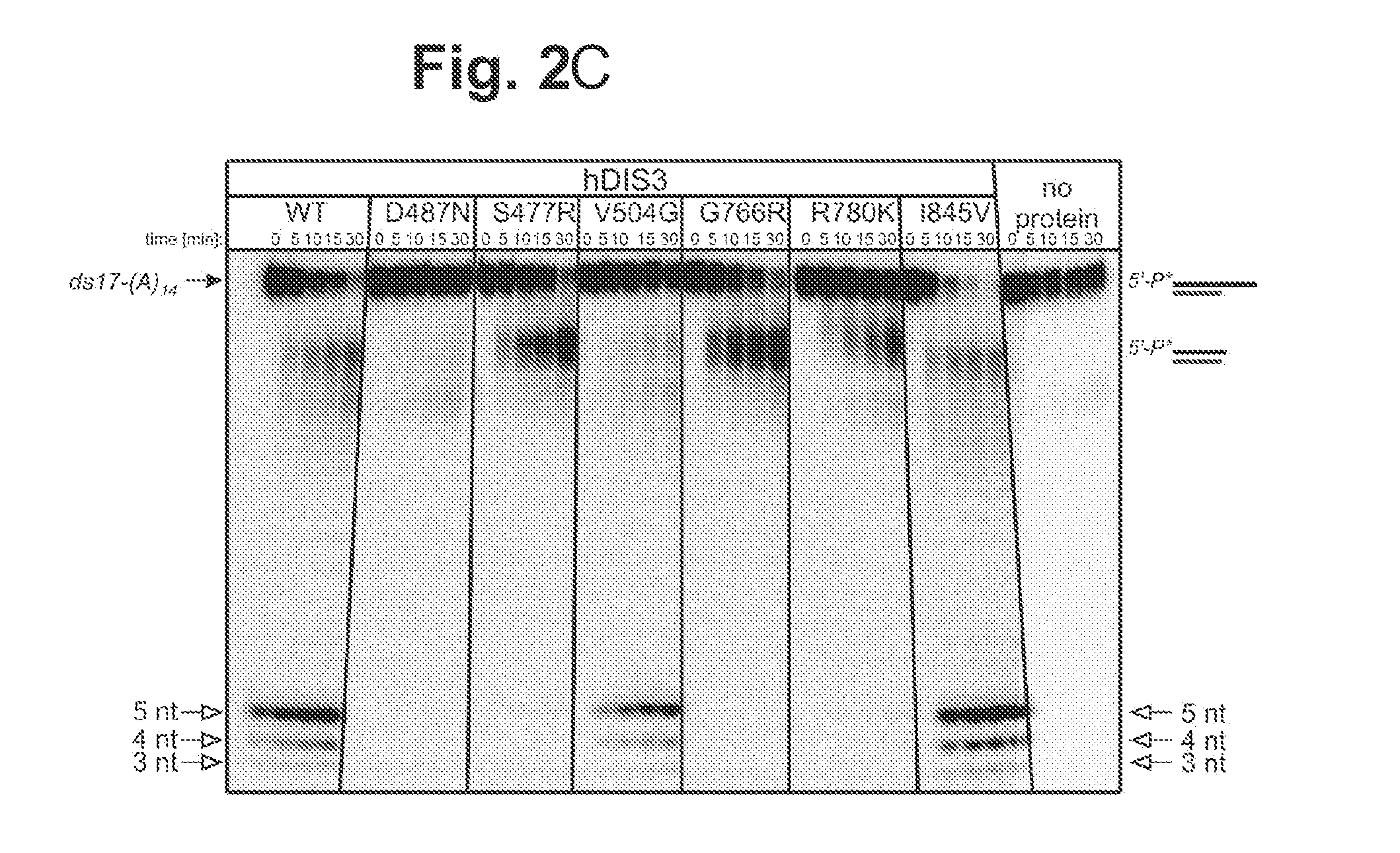Method for selection of hDIS3 PIN domain inhibitors and use of hDIS3 PIN domain inhibitors for cancer treatment
- Summary
- Abstract
- Description
- Claims
- Application Information
AI Technical Summary
Benefits of technology
Problems solved by technology
Method used
Image
Examples
examples
[0101]In the following examples, unless specified otherwise, standard materials and methods are used as described in Sambrook J. et al. “Molecular Cloning: A Laboratory Manual, 2nd edition, 1989, Cold Spring Harbor, N.Y. Cold Spring Harbor Laboratory Press, or proceeding in accordance with manufacturers' recommendations for specific materials and methods.
Bacterial Strains
[0102]The following E. coli strains were used: MH1 (E. coli araD lacX74 galU hsdR hsdM rpsL), dam- / dcm-(New England Biolabs; E. coli ara-14 leuB6fhuA31 lacY1 tsx78 glnV44 galK2 galT22 mcrA dcm-6 hisG4 rfbD1 R(zgb210::Tn10) TetS endA1 rspL136 (StrR) dam13::Tn9 (CamR) xylA-5 mtl-1 thi-1 mcrB1 hsdR2), BL21-CodonPlus-RIL (Stratagene; E. coli B F− ompT hsdS(rB− mB−) dcm+ Tetr gal endA Hte [argU ileY leuW Camr]).
Yeast Strains
[0103]S. cerevisiae strain encoding fusion of wild-type Dis3p with and protein A tag-TEV protease cleavage site and TRP selection marker (ADZY532; referred herein to as wt) was a derivative of haploid...
example i
[0107]Proteins Encoded by some hDIS3 Gene Versions with MM-Associated Mutations Display Various Defects in the Degradation of Different RNA Substrates.
Oligonucleotides, plasmids and cloning.
[0108]The E. coli BL21-CodonPlus-RIL strain was used. Plasmids pMM1, pMM2, pMM3, pMM4, pMM5 and pMM6 (for heterologous expression of various hDIS3 versions in E. coli) were generated by site-directed mutagenesis with oligonucleotide pairs shown in Table 1, using a pHEX1 construct (encoding wild-type hDIS3; Tomecki et al. 2010b) as template.
TABLE 1Primers used for site-directed mutagenesis and construction of recombinant hDIS3variants bearing MM-associated mutations, for heterologous expression in E. coli.Seq.Id.ConstructedhDIS3NameNucleotide sequence (5′-3′)NoplasmidvariantS477RforTGTGTATCTGCAGAGTAGACCCACCAGGATGTACTGATATAG7pMM1S477RS477RrevGGTCTACTCTGCAGATACACAGATGCCTCAGGTCTTCTCGG8V504GforAGGT TGGTGGCCATATTGCTGATGTGAGCCATTTTATTAGG9pMM2V504GV504GrevAGCAATATGGCCACCAACCTCCAAATTTCCATTTTCGAGTTC10A524P...
example ii
[0116]Mutations in yeast DIS3 gene corresponding to those found in MM patients cause cell-growth defects and molecular phenotypes leading to an impairment of the exosome function.
S. cerevisiae strains (yeast strains) and construction of mutants.
dis3-V568G, dis3-A588P, dis3-G833R and dis3-R847K mutants (see FIG. 1A for corresponding human amino acid changes) were constructed as follows. A diploid BMA64 strain was transformed with DNA fragment containing DIS3 gene harboring a respective mutation, a tag (encompassing TEV protease cleavage site and sequence encoding protein A) and the TRP selection marker. First, two parts of the DIS3 gene were produced in two independent amplifications: 5′ using ADZKD106 forward primer, complementary to the sequence located upstream the Dis3p coding sequence and suitable reverse primer ADZKD134, ADZKD136, ADZKD138, ADZKD140 covering the mutated site; and 3′—with appropriate forward primer ADZKD133, ADZKD135, ADZKD137, ADZKD139 covering the mutated site...
PUM
| Property | Measurement | Unit |
|---|---|---|
| Lethality | aaaaa | aaaaa |
Abstract
Description
Claims
Application Information
 Login to View More
Login to View More - R&D
- Intellectual Property
- Life Sciences
- Materials
- Tech Scout
- Unparalleled Data Quality
- Higher Quality Content
- 60% Fewer Hallucinations
Browse by: Latest US Patents, China's latest patents, Technical Efficacy Thesaurus, Application Domain, Technology Topic, Popular Technical Reports.
© 2025 PatSnap. All rights reserved.Legal|Privacy policy|Modern Slavery Act Transparency Statement|Sitemap|About US| Contact US: help@patsnap.com



